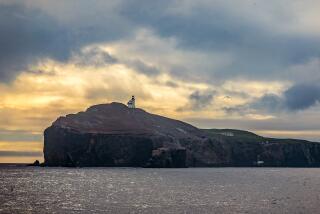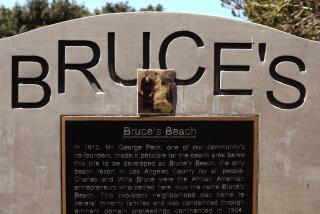Family Gets $12.7 Million for Lost Land
- Share via
After nearly two decades of contentious negotiations, a federal jury in Los Angeles awarded $12.7 million Friday to the Gherini family to compensate them for the ranch they lost when the government created Channel Islands National Park.
Family patriarch Francis Gherini said in a statement that he felt vindicated by the jury’s verdict, reached in five hours after a three-week-long trial before U.S. District Judge Richard A. Paez.
“All I ever wanted was the fair market value for my share of the largest island off the California coast,” Gherini said in the statement released by his lawyer, Roger M. Sullivan. “It never should have come this far. I’m a reasonable man.”
With authorization from Congress, the National Park Service seized control of Francis Gherini’s 6,300 acres of Santa Cruz Island in 1996, more than a decade after the island was designated part of the five-isle chain of parkland off the Ventura County Coast.
The government offered $4 million for Gherini’s land, but he spurned the deal, claiming the land was worth $14 million. After years of negotiations, Congress took the property and Gherini filed suit.
“You can’t put into words how difficult this has been,” said Andrea Gherini, Francis’ daughter, a lawyer who helped represent him in court. “It’s been such an emotional two years--losing our property and losing our right to visit it.”
An attorney for the park service, Joy Ryan, refused comment on the jury award. Channel Islands National Park spokeswoman Carol Spears declined to discuss the verdict, saying, “I don’t want to comment on something I haven’t seen.”
Francis Gherini’s great-grandfather, Justinian Caire, bought the rugged, wind-swept island in 1879 and settled it as a cattle and sheep ranch and winery. Throughout the Depression, ownership of much of the island changed hands, but the Gherinis held fast to 10% of it.
The fight between the Gherinis and the federal government started in 1980, when the northern Channel Islands were designated a national park and Congress authorized the purchase of the family’s remaining acreage.
But the purchase agreement stalled for years as family members pushed the federal government to pay what they believed was the appropriate amount for the land.
Andrea Gherini said federal officials routinely tried to low-ball her family during negotiations, leaving her father to wonder if he would ever see a penny for the gem-green land.
“The government likened it to a parcel in Riverside County designated a preserve for kangaroo rats--a piece of land where there is no ocean frontage and no ability to develop it,” she said. “The government said that had more value than the Gherini Ranch on Santa Cruz Island. That gives a flavor of what we’ve been fighting for 20 years. The government never wanted to value it fairly.”
In the early 1990s, the government managed to buy the interests of Francis Gherini’s three siblings for about $4 million apiece. But the former Oxnard attorney rejected the offer as too low, keeping his 25% interest in the 6,264-acre ranch and leaving the park service with 75%.
Park officials continued negotiations in recent years, but said they were constrained by law from paying more than fair market value.
In 1995, park officials were still reviewing appraisals of the land, hoping they could meet Gherini’s price and snatch up the last privately owned land in the national park.
Then in November 1996, frustrated government officials decided to force Gherini to sell the ranch. He countered with a lawsuit.
Park officials said they were eager to restore the island’s natural habitat, which had been overgrazed by thousands of feral sheep left over from the family’s old farming operation.
Justinian Caire brought merino sheep to the island in the 1880s for their fine wool. The family never eradicated the woolly descendants as was done on the rest of the island.
For years, the family charged bow-and-arrow hunters $500 each to pursue the sheep. The game concessionaire has since been shut down and park service officials are trying to slowly remove all the sheep. About 2,000 still roam the island’s east end.
Times staff writer Gary Polakovic contributed to this report.
More to Read
Sign up for Essential California
The most important California stories and recommendations in your inbox every morning.
You may occasionally receive promotional content from the Los Angeles Times.










